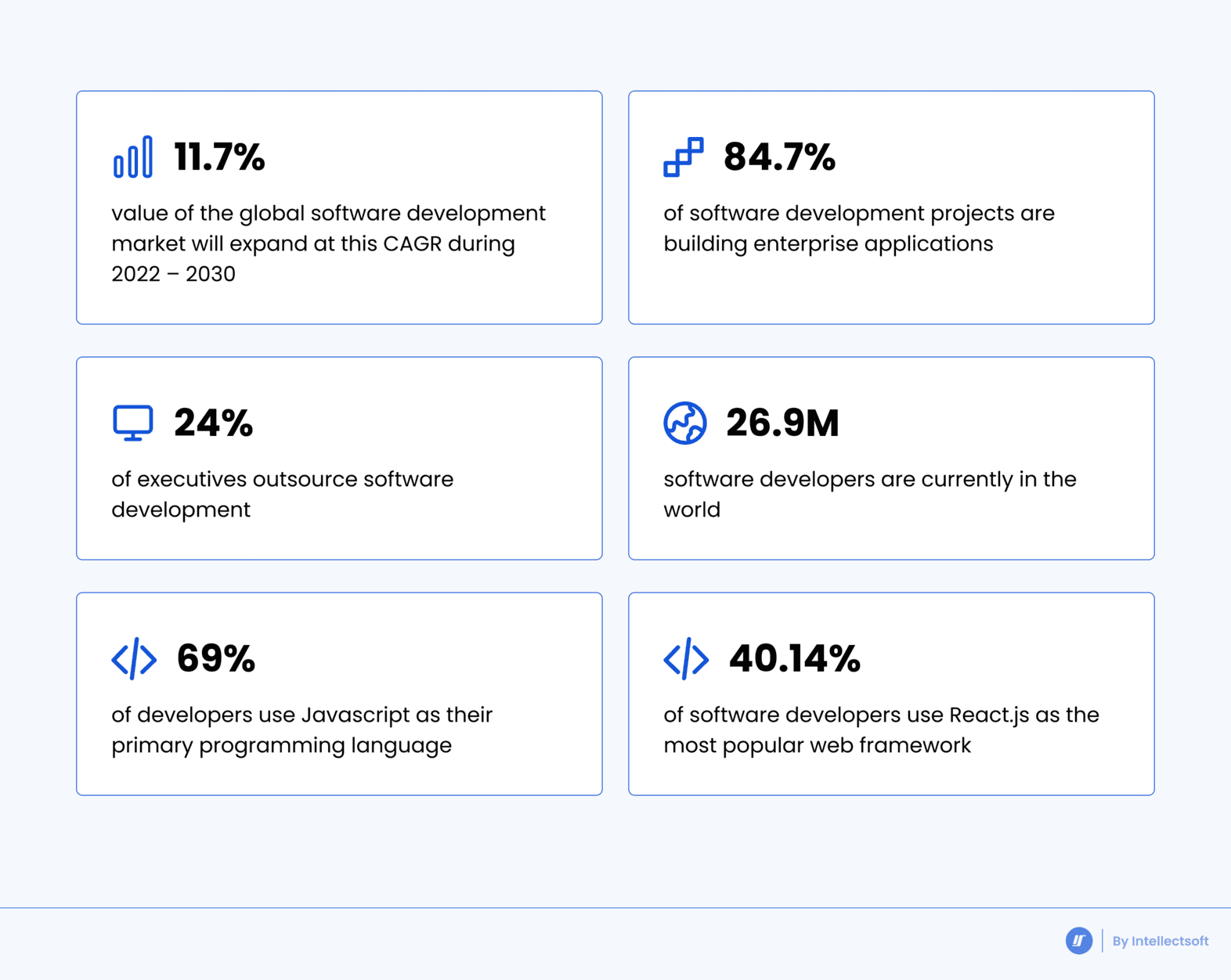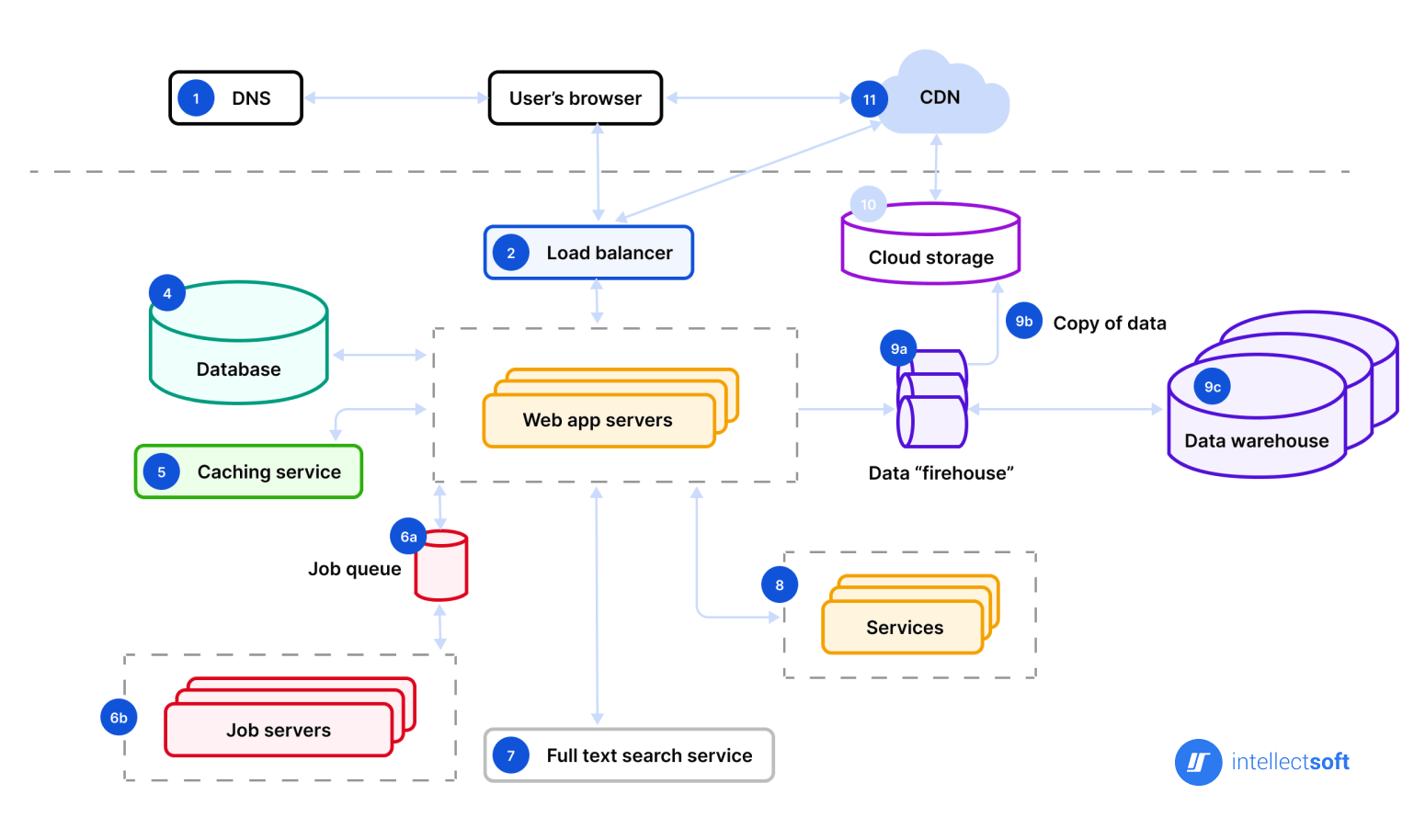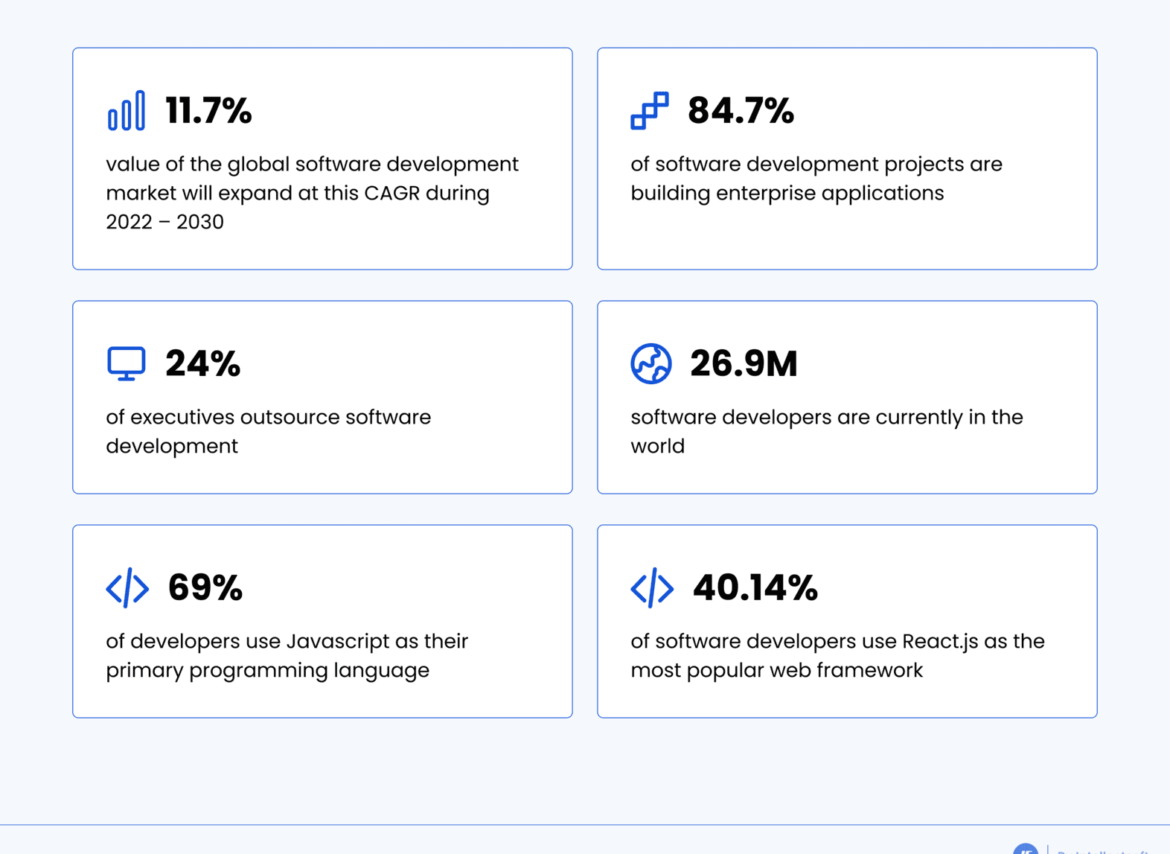The web application market is an environment that is continuously evolving, incorporating new technologies and increasing safety standards.
In this regard, the proper attention to the foundational web app development contributes to maintaining the required robustness, responsiveness, and security of this software. In a web app, this is what solid web app architecture is responsible for.


The definition of web app architecture is broad and depends on the focus of building web applications.
A web application architecture is a model of interaction between web application components. The specific kind of architecture for web applications strictly depends on the way application logic will be allocated among client and server sides.
Technically, it’s the skeleton of a web app, including its elements, databases, systems, servers, interfaces, and all the communication happening between them. In more abstract terms, it indicates the logic behind responses to client and server requests.
When it comes to business benefits, web application architecture is related to the process of creating web applications and planning for their needs in terms of speed, scalability, security, and other quality attributes.
This article will provide an overview of modern web application architecture, including its key components, types, and models, so that you can invest in this type of architecture with confidence. Let’s get started!
Components of Web Application Architecture
The applications differ in complexity and functionality, and the number of layers and components changes accordingly. It may happen that an app is so simple that it works as a monolith, storing all the web application design architecture in one place.
Nevertheless, a typical web app will consist of multiple components (or tiers) that interact with each other. Usually, the two major groups for web application architecture are user interface and structural web components. In their turn, structural web components include client-side components and server-side components.
When too many components are involved, their descriptions may not be enough to clarify the whole picture. A web application architecture diagram can help in this situation by presenting a schematic illustration of components and interactions between them. Now, let’s take a closer look at the key elements depicted on this diagram.


1. DNS
The abbreviation DNS stands for the domain name system. It’s a key element that matches IP addresses to domain names. In this way, a particular server receives a request sent by an end user.
2. Load Balancer
It directs incoming requests from app users to one of the multiple servers, which distributes load more evenly when too many users are active at the same time. Generally, web app services exist as various copies mirroring one another to enable all servers to process requests in the same manner. Also, the load balancer is an element that distributes tasks in order to prevent them from overcharging.
3. Web App Servers
This component is basically an app deployment descriptor. What does it mean? It means that it processes the user’s requests and sends responses back to an initial browser. To make it happen, it refers to the back-end infrastructure, including the database, job queue, cache server, etc.
4. Database
The meaning of this component is pretty much straightforward. It offers a wide variety of instruments to perform, delete, organize, and update data entries. Mainly, web app servers interact with job servers without any intermediary.
5. Caching Service
The component grants easy and quick data storage and search. When the user receives the info from the server, search results can be cached. As a result, future requests will be returned much faster.
These are the scenarios when caching is efficient:
- Slow or repeated computation
- When a user receives similar results for a specific request
6. Job Queue (Optional)
This one has two components in it, which are a job queue and servers that process those jobs. Many web servers operate a large number of jobs of minor importance. A job that has to be fulfilled goes in the queue and will be operated according to the schedule.
7. Full-Text Search Service (Optional)
There are plenty of web apps that support search by text feature. After this, an application sends the relevant results to an end user. The whole process is called a full-text search, and it can find the requested data by a keyword among all the documents available in a system.
8. CDN
The abbreviation CDN stands for the content delivery system. This system sends static content, including images and other files. Basically, it includes multiple servers that are closer to the geographical locations of end users than an app’s database. As a result, CDN delivers content more effectively to users around the globe, drastically reducing load times.
What is a 3-tier Architecture?
The majority of web apps are created through the separation of their principal function into layers/tiers. Respectively, this enables you to quickly and effortlessly replace or upgrade those layers independently. It is called a multi- or a 3-tier architecture.
In a 3-tier web architecture, there are three layers/tiers:
- Presentation (client) layer
- Application (business) layer
- Data access layer
It’s possible to say that this modern web app architecture is the safest and most secure one. It can be explained by the fact that the client doesn’t access the data directly. Application servers can be deployed on multiple machine providers, which enables higher scalability, increased performance, and better efficiency.
Each tier can be scaled independently; therefore, this architecture can be scaled horizontally. In addition, it also significantly improves the overall data integrity as data will go through the app server, which is the one that decides exactly how and by whom data will be accessed. This amazing perk is an easy and cost-effective solution in case of new company management.
Modern Web Application Architecture Layers
Now, let’s take a closer look at each of the three web application architecture layers.
Presentation/Client Layer
When we are talking about the presentation layer, we imply the front end of an app. This layer includes such elements as static content and dynamic interface that are visible to end users. The environment of this layer is any browser. Among the technologies that are used in this case, we can name HTML, CSS, or JavaScript. The potential frameworks to choose from include Angular, React, and Vue.
Business/Application Layer
Speaking of the business layer, which is also referred to as the application layer, is a part of the app back-end. The web app’s back-end determines business logic and responses to browser requests that are sent to the presentation layer. It consists of the core application logic and outlines all internal flow for data and requests. In this case, the most convenient environment is servers, serverless cloud platforms, or PaaS. Among the programming languages that are used in this case, we can name C#, JavaScript, Java, Python, and PHP. The potential back-end frameworks to choose from include ASP.NET, express.js, nest.js, Spring, Flask, Django, and Symfony.
Data Access Layer
The final layer in this architecture is the data access layer, which plays a crucial role by closely interfacing with the business layer, retrieving essential information from the servers. Simultaneously, the data service layer acts as an intermediary, effectively segregating the business logic from the client side during request processing.
It is an app back-end part that contains databases and DBMS (database management systems) that collect, manage and store data. The environment can be the same as the application layer. Among the Database management systems, we can name PostgreSQL, Microsoft SQL Server, MySQL, MongoDB, Cloud Offerings and so on.
All the layers work independently and communicate with each other through the relevant components.
Types of Web Application Architecture
A web application architecture type is a particular pattern under which the components interact with each other. The overarching layers might be divided into a client side architecture, server side architecture, and a hosting approach.
Client Side
Single-Page Application Architecture
This web application architecture is designed to show relevant content only. To make this happen, it first loads the relevant web page and then dynamically updates the representation of its content with the requested information only.
In other words, it doesn’t refer to the server for loading new pages but sends requests for the needed parts of the webpage only.
Single-Page Applications contribute to smoother performance and a more intuitive user experience.
Pros of single-page app architecture:
- Faster performance
- Improved flexibility of UX
Cons of single-page app architecture:
- Increased testing time
- Possible loss of unsaved progress
- Slower first-load speed
Progressive Web Apps
Progressive web apps are still among the most promising web app trends thanks to their unique format. They offer a convenient and effective user experience available from any browser and device through a shared URL.
The application of progressive web apps is wide, including industries like entertainment, finance, and eCommerce. Their key benefits include lightweight, cost-effectiveness, cross-device nature, ability to attract web traffic, and a fully functioning app experience.
Pros of progressive web app architecture:
- Browser availability
- Mobile-first approach
- Increased traffic
- Effective offline performance
Cons of progressive web app architecture:
- Restricted browser support
- Narrow utilization of native APIs.
Server Side
Microservice Architecture
Microservices are the frequent alternative to an unreliable monolithic web application architecture. They disperse the functionality to deliver small and lightweight services separately.
In particular, they are loosely coupled and use APIs for communication if a sophisticated business problem arises. This peculiarity eases the developer’s life since it’s possible for individual service components to be built in different programming languages.
Thanks to its flexibility and stability, microservice architecture has gained popularity these days, with businesses like Amazon, eBay, and Netflix adopting it for their complex needs.
Pros of microservice architecture:
- Easier scaling up
- Better fault tolerance
- Simple-to-understand code base
- Independent module deployment
Cons of microservice architecture:
- Difficulties with testing and debugging
- Complex deployment
Hosting Approach
Serverless Architecture
In web application development, this architecture type, you outsource both server and infrastructure management to a third-party cloud service provider. This way, a web app logic execution won’t intervene in the infrastructure running.
Choosing a serverless architecture is good for companies that want to delegate server and hardware management to a reliable tech partner and concentrate on front-end development tasks instead.
Also, this web application architecture type allows working on small functions in apps. The service providers that assist in server management are Amazon and Microsoft, among others.
Pros of serverless architecture:
- Absence of server management
- Highly scalable
- Minimized latency
- Speed and flexibility
Cons of serverless architecture:
- Security concerns
- High complexity
Advanced & Scalable Web Application Architecture
Digital technologies constantly evolve, creating new possibilities for web applications. As a result, their architecture also evolves to accommodate software to new demands and conditions in business. These days, the challenges in various industries require appropriate actions and implemented measures from software developers. Let’s see what business requirements have the largest impact on software development and how specialists can ensure the necessary characteristics of web applications using new trends and a properly designed architecture.
Three of the most demanded characteristics of web applications nowadays are improved scalability, reliability, and security. Business needs to be sure that custom software is reliable and won’t fail under load or malicious actions. To satisfy these requirements, developers continually enhance software architecture by implementing more advanced technologies and higher standards.
Today, most requirements regarding the scalability and safety of web applications are met with the help of cloud technologies. Web developers extensively use them for two main purposes: advanced storage and delivery of content and smart balancing of traffic load.
Cloud solutions are the most obvious and optimal choice of technologies for the architecture of most business web applications. That’s why a lot of web developers effectively use a wide range of cloud services provided by such IT giants as Amazon, Microsoft, and Google. Today, Amazon Web Services, Microsoft Azure, and Google Cloud Platform are essential tools that can be customized for all types of web applications. Here are a few examples of uses and benefits associated with cloud services implementation in web app architecture.
Data Storage Tools
- Amazon S3
- Azure Cloud Storage
- Google Cloud Storage
Storing web app information in the cloud instead of an on-premise server makes data more accessible regardless of users’ location. Most cloud service providers offer several subscription plans with various volume and traffic load capacities. They ensure that your information is kept safe and secure, which is an invaluable advantage for business.
Cloud storage also allows developers to optimize access time for users in target geographic areas. This way, customers or employees using a web application will experience fewer lags. After a web application is released, developers can add new cloud storage units or remove existing ones and change the service subscription plan. This significantly improves scalability and optimizes app costs depending on the scale of the business.
Load Balancing Tools
- AWS Elastic Load Balancing
- Azure Load Balancer
- Google Cloud Load Balancing
Load balancers ensure the smooth work of a web application even at times of high traffic loads. This type of technology is especially useful for B2C or retail businesses. Usually, such high load periods are predicted and happen on a regular basis, for example, during holiday seasons. However, sometimes, they occur as a result of malicious attacks intended to disrupt the online operations of a particular company. The most common type is DDoS attacks which can have a devastating impact on any online business. Load balancing technologies help to distribute excess loads across multiple servers using hardware or software components and predefined policies.
Caching and Content Delivery Tools
- Amazon CloudFront
- Azure CDN
- Google Cloud CDN and Media CDN
- CloudFlare
Software developers may implement a caching system in application architecture to optimize data access and improve app performance. Usually, an app cache contains the most frequently or recently requested information. It delivers data to a user device much faster than requesting the same information from a database on an application server.
Depending on the architecture, a web application may have a global cache, a distributed cache, or an in-memory cache. Another widely used technology to handle caching is a content delivery network (CDN). It allows developers to reduce load on an application server by rerouting queries to a CDN server instead.
Web Application Architecture Best Practices
Here, we’ve gathered the top 5 recommendations for business owners to consider while working on web app architecture for their projects and building cooperation with tech partners.
1. Think of a proper web application architecture at the earliest stages
Without a comprehensive structure, your application will turn into a labyrinth of messy elements and components that are too hard to handle.
2. Don’t copy somebody’s success
The top mistake is to pick a web application architecture of a successful company and simply replicate it. In reality, a successful architecture is one that corresponds with your business goals and ideas, not theirs.
3. Pay attention to your technical limitations
It’s not always possible to get the best and most successful elements in your web application architecture. However, with the proper attention to quality attributes and realistic business expectations, you will get the maximum from all the components you have.
4. Eliminate the problems right away
Don’t wait for the web app release to fix the problems in its architecture. The earlier you address the issues, the more reliable core features it will have.
5. Create a checklist of successful web app features
To make sure your web app has achieved its goal, it’s good practice to note your expectations from it at the very beginning and discuss their possibility and measurable KPIs with your tech partner.
The possible checklist may include these features:
- Overall system flexibility
- Components can be reused
- Well-written code
- Ability to scale
- System stability
- Easy bug detection
- Sticking to security standards
- Fields to work with user feedback
- No crashes
- Easy-to-use
- Responds fast
- Can be deployed automatically
Summing Up
A solid, fast-working, scalable, and safe web application architecture is a must for every web platform-based digital product, especially when it comes to business. For this reason, the architecture must always be developed and implemented by software engineering experts with experience in creating similar solutions for your specific industry.
Intellectsoft is a company that has been creating digital solutions for companies of all sizes in Fintech, Healthcare, construction, hospitality, logistics, eCommerce, and many other industries for over 15 years. We provide web development services to startups, SMBs, and enterprises across the world and create solutions with the most efficient, safe, and flexible web app architecture.
So, if you’re looking for a development team that will ensure top-quality modern web application architecture, here are only a few reasons to choose our software engineering experts:
- Our talent pool covers dozens of programming tools and technologies for building web, mobile, desktop, cloud, and other solutions.
- We have successfully finished and delivered over 600 digital solutions for businesses. Here, you can see our most prominent cases.
- Our engineering workforce is located in 21 countries across the Atlantic.
- The size of our clients varies from early-stage startups to Fortune 500 enterprises like Audi, Harley Davidson, Universal, Nestle, Melco, and others.
In case you want to know what custom web application architecture solution we can create and provide for your business, don’t hesitate to get in touch with us and tell us what you need. Our team will make sure your product gets its perfect modern web app architecture.
FAQ
What web app architecture will fit my needs?
First of all, it’s essential to define your business goals and objectives. Once you do this, it will be so much easier to decide on what specific type of web application architecture you should opt for. However, if after reading our detailed guide, you still don’t know which type to choose, then we recommend you contact our professional team. We will gladly evaluate your project and suggest the most relevant solution in your particular case. In addition, we will be able to provide you with the approximate costs for selecting and creating web application architecture delivered by Intellectsoft.
What are the reasons to treat a web application system architecture seriously?
There are multiple benefits of a web application architecture that should motivate you to treat it really seriously. First of all, it enables very simple and fast integration of new features into your application. In addition, web architecture has high flexibility and scalability, which is also very beneficial for your project. Moreover, working with the right web application architecture will decrease the time spent on web development. It also goes without saying that this solution is very cost-effective and will grant you exceptional safety.
What are the most popular models of web app architecture?
There are three popular models of architecture used in modern web applications.
The “one server, one database” model is rather primitive and does not meet the requirements of modern web software. However, its simplicity allows developers to use it for pre-release testing or for building an MVP. In real-life applications, this model does not ensure the appropriate level of safety and stability because if a server goes down, an app will stop working as well.
The “multiple servers, one database” model is faster and more effective due to its partially distributed nature. The presence of several servers enables the possibility of load balancing, which allows using the full potential of multiple app servers. However, the single database is a potential vulnerability that impacts the safety of a web application.
The “multiple servers, multiple databases” model is the most efficient but also the most expensive in terms of deployment and maintenance. Developers must implement effective means to synchronize information within several databases. Like the previous model, this one may also use the benefits of load balancing.
What are the business advantages of a well-planned web architecture?
For many online retail companies, a custom web application is the only way to showcase goods, take orders, and communicate with customers. A properly designed and implemented architecture ensures that app users can perform all intended activities regardless of their location, current traffic load, or other factors impacting the app’s performance.
Let’s take, for example, a 3-tier web architecture in the context of a retail business app. The presentation layer displays information using a graphical user interface. This way, a customer can interact with the app: browse products, compare or add them to the cart, and so on. The business layer is the core of an application that determines its functionality. It processes the information gathered during the user interaction and acts as a medium between the presentation layer and the data layer. Finally, the data access layer or simply data layer stores and manages information, including product descriptions, availability, price, and more. This layer also includes customer-related information which usually contains delivery addresses, saved payment options, and other personal data. Considering potential financial and reputational losses, database security is extremely important and should be considered a top priority.
Software developers must ensure the efficient and reliable operation of all these layers using carefully chosen technologies and a well-implemented architecture of a web application. First of all, a convenient and fast app improves customer satisfaction which leads to more profits and higher client retention. It also helps businesses to remain online and functional even during periods of heavy loads, preventing crashes and other failures. Last but not least, a carefully designed architecture is essential for the security of a web application, which is a crucial factor for business owners and their clients alike.
Subscribe to updates
Source link











